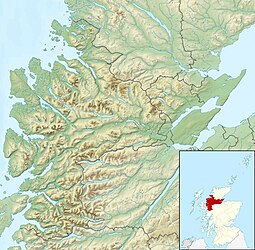Gruinard Island
| Gaelic name | Eilean Gruinneart |
|---|---|
| Meaning of name | "Shallow firth", from Norse |
| Location | |
|
Gruinard Island shown within Ross and Cromarty
|
|
| OS grid reference | NG945945 |
| Coordinates | 57°53′N 5°28′W / 57.89°N 05.47°W |
| Physical geography | |
| Island group | Inner Hebrides/Islands of Ross and Cromarty |
| Area | 196 hectares (0.76 sq mi) |
| Area rank | 111 |
| Highest elevation | An Eilid 106 metres (348 ft) |
| Administration | |
| Sovereign state | United Kingdom |
| Country | Scotland |
| Council area | Highland Council |
| Demographics | |
| Population | 0 |
| Population rank | 0 |
| Largest settlement | None |
| References | |
Gruinard Island (/ˈɡrɪnjərd/ GRIN-yərd;Scottish Gaelic: Eilean Ghruinneard) is a small, oval-shaped Scottish island approximately 2 kilometres (1.2 mi) long by 1 kilometre (0.62 mi) wide, located in Gruinard Bay, about halfway between Gairloch and Ullapool. At its closest point to the mainland it is just over 1.1 kilometres (0.68 mi) offshore. The island was made dangerous for all mammals by experiments with the anthrax bacterium, until it was decontaminated in the late 20th century.
The island was mentioned by Dean Munro who travelled the area in the mid 16th century. He wrote that it was Clan MacKenzie territory, was "full of woods", (a striking comparison with its treelessness today) and that it was "guid for fostering of thieves and rebellis".
The population was recorded as six in 1881, but Gruinard has been uninhabited since the 1920s.
Gruinard was the site of a biological warfare test by British military scientists from Porton Down in 1942, during the Second World War. At that time there was an investigation by the British government into the feasibility of an attack using anthrax. Given the nature of the weapon which was being developed, it was recognised that tests would cause widespread and long-lasting contamination of the immediate area by anthrax spores. To limit contamination, a remote and uninhabited island was required. Gruinard was surveyed, deemed suitable and requisitioned from its owners by the British Government.
...
Wikipedia

